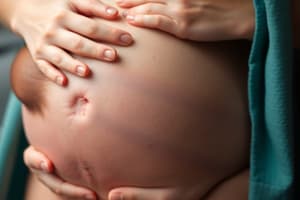Podcast
Questions and Answers
What are known factors responsible for the initiation of spontaneous labor?
What are known factors responsible for the initiation of spontaneous labor?
- Increase of oxytocin and withdrawal of estrogen
- Increase of estrogen and withdrawal of prostaglandins
- Withdrawal of progesterone and an increase of prostaglandins (correct)
- Withdrawal of oxytocin and increase of progesterone
What stimulates the release of oxytocin from the posterior pituitary?
What stimulates the release of oxytocin from the posterior pituitary?
- Withdrawal of progesterone
- The fetus pressing on the cervix (correct)
- The increasing size of the fetus
- Increase of estrogen
What works together with prostaglandins to initiate contractions?
What works together with prostaglandins to initiate contractions?
- Withdrawal of progesterone
- Increase of estrogen
- Oxytocin stimulation (correct)
- The increasing size of the fetus
What results in the release of prostaglandins?
What results in the release of prostaglandins?
What leads to changes in the ratio of estrogen to progesterone?
What leads to changes in the ratio of estrogen to progesterone?
Flashcards are hidden until you start studying
Study Notes
Initiation of Spontaneous Labor
- Multiple factors contribute to the onset of spontaneous labor, including hormonal changes, mechanical factors, and biochemical signals from the fetus and placenta.
- Fetal maturation is a crucial signal, releasing stress hormones and influencing uterine contractions.
Oxytocin Release
- Oxytocin is released from the posterior pituitary gland, primarily stimulated by cervical stretching and uterine contractions during labor.
- Sexual arousal and nipple stimulation can also trigger oxytocin release, promoting uterine contractions in the later stages of labor.
Contraction Initiators
- Prostaglandins work in tandem with oxytocin to initiate and strengthen uterine contractions.
- The combined action of these hormones helps facilitate the labor process and promotes cervical dilation.
Prostaglandin Release
- The release of prostaglandins is triggered by cervical ripening, labor onset, and the pressure exerted by the fetus against the cervix.
- Inflammatory mediators and fetal-produced factors contribute to an increase in prostaglandins to aid the labor process.
Estrogen to Progesterone Ratio
- The shift in the estrogen to progesterone ratio is influenced by the maturation of the fetal adrenal glands and the release of adrenal precursors.
- At term, there is an increase in estrogen levels alongside a decrease in progesterone, promoting uterine excitability and readiness for labor.
Studying That Suits You
Use AI to generate personalized quizzes and flashcards to suit your learning preferences.




